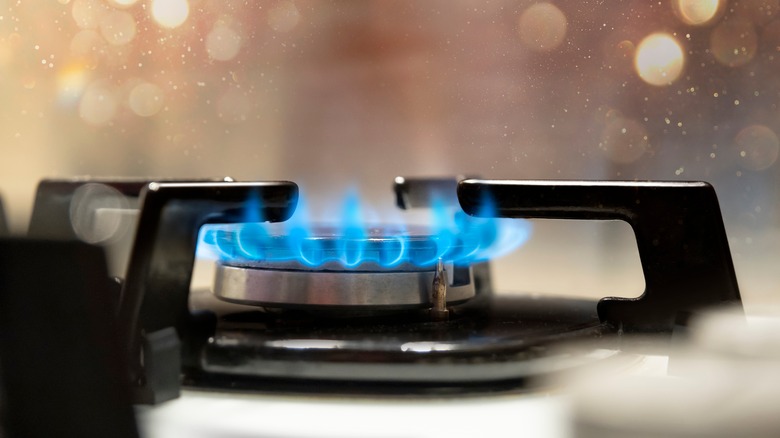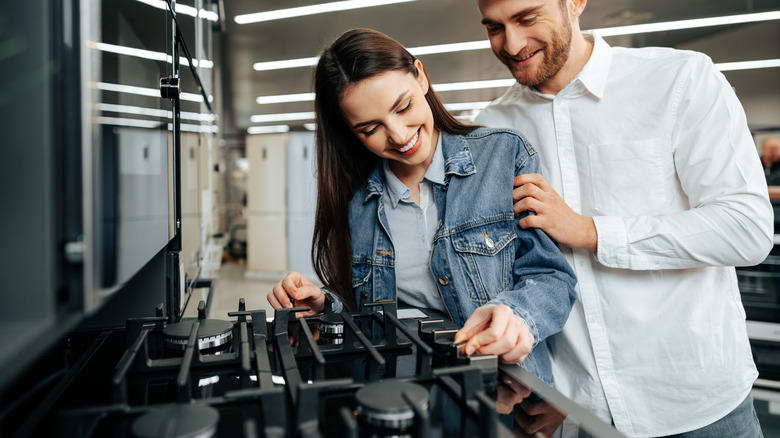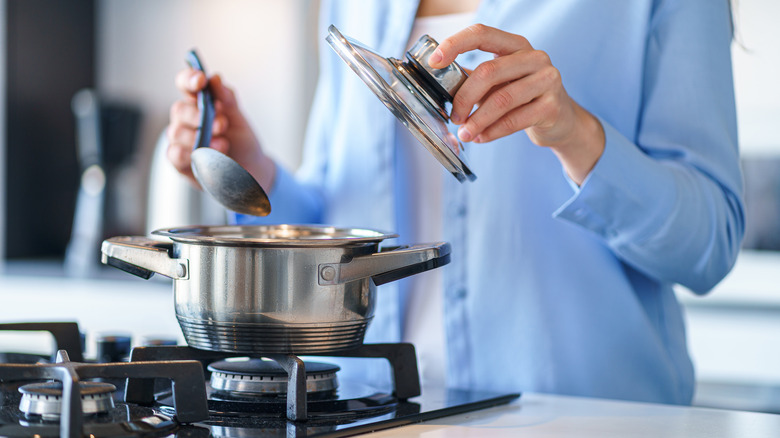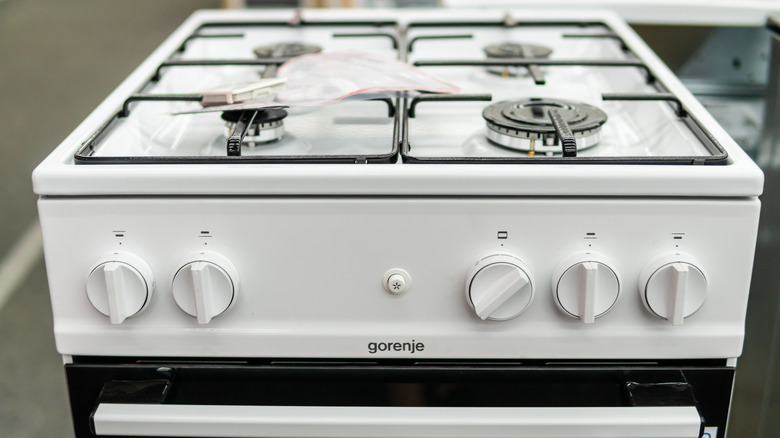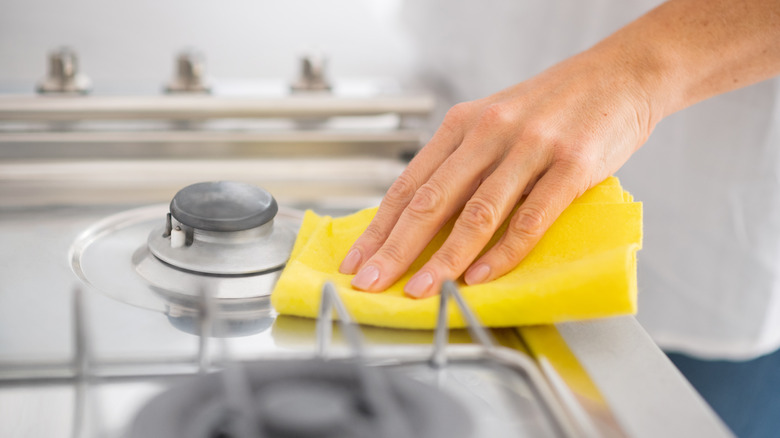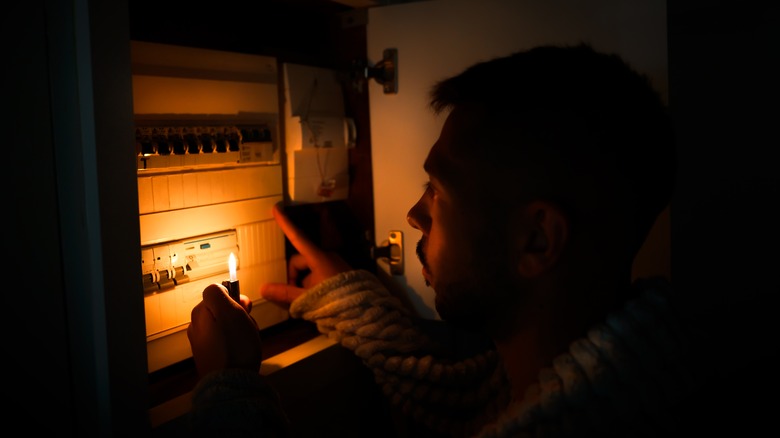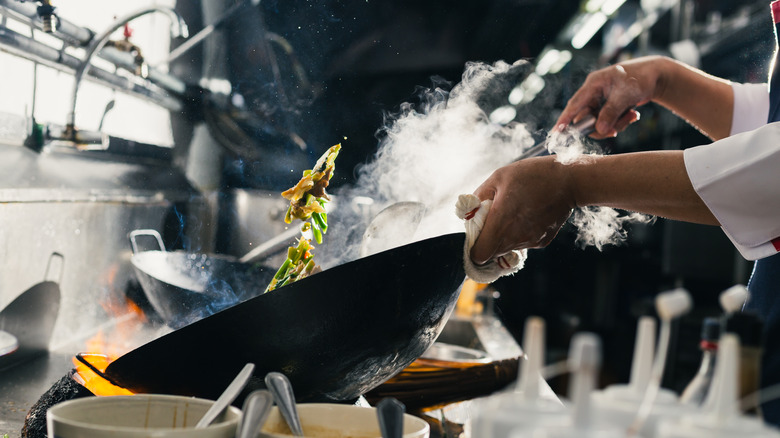How Much Does It Cost To Put In A Gas Stove?
Today, many stoves are powered by electricity and, although Aran Cucine claims that electric stove tops are cheaper to buy and easier to clean and maintain, they don't provide the same control or adjustability as a traditional gas stove. Unlike electric stove tops, gas stove tops provide you with a contained open flame to safely cook on, explains Cooker Spare Parts. Moreover, Pulte Homes note that many people, especially professional chefs, prefer gas stoves as opposed to electric stoves for their ability to heat up instantly and be used with a variety of different cookware. The cost of this kitchen appliance, however, does not come cheap.
Forbes claims that most homeowners spend an average of $2,800 for the purchase and installation of a gas stove. This price varies depending on the quality of the stove. Some stoves can be found for under $1,000, while a top-of-the-range model can be as much as $4,200. Keeping this in mind, it is important to consider the factors that make up this total price and what a gas stove can bring to you and your home.
Factors for cost
When it comes to installing a gas stove in your home, there are a few factors that affect the overall cost. Let's take a look at some of them below and analyze their importance to the overall project.
Materials
The main outlay when installing a new gas stove is the stove itself. Forbes states that the cost of a gas stove alone can range anywhere between $1,000 and $4,200. If you choose to install a ventless gas stove, you can expect your cost of materials to be on the lower side, ranging between $1,000 and $2,200. Installing a vented gas stove, however, is a little more expensive due to the extra ducting that is required, which can increase your cost of materials to between $2,200 and $2,600.
Labor
It is highly recommended to let a professional install the stove. This guarantees both the correct functionality of your appliance as well as the safety of your home. Costimates states that the average cost of hiring a professional to hook up your gas appliance should be $150 to $300. A professional will ensure that the gas lines and pipes are in good condition before attaching your appliance and testing it to make sure everything works correctly. Any additional work, such as installing vents or ducting, should be carried out at this time and will increase the cost of labor.
Permit
According to Upgraded Home, most home locations require a permit before installing a gas appliance. This is done because when improperly installed appliances can leak, causing dangerous situations. In terms of insurance and selling your home, having a permit before installing your gas stove is vital. When seeking a permit, costs vary between locations. On average, however, HomeGuide states that you can expect to pay between $50 and $300 for an installation permit.
Additional costs
In addition to the initial cost of installing a gas stove into your home, some additional expenses must also be considered regarding your new gas stove's ability to function.
Gas lines
If one does not already exist, you will need to install a gas line to ensure a safe and steady fuel supply for your appliance. HomeGuide estimates that the cost of the gas line will mainly depend on its length. For a kitchen stove, you can expect to pay anywhere between $15 and $25 per linear foot, with most households needing an average of 30 feet.
Usage
Like all appliances, using your gas stove will also cost you money. Although the initial price of a gas stove is much higher than an average electric stove, the cost to use a gas stove is surprisingly cheaper. How To Fix It explains that using an electric stove costs an average of $10.95 a month. A gas stove, on the other hand, proves to only cost around $6.99 a month for all your cooking needs. The exact price to use your gas stove, however, also depends on the type of gas your use since natural gas costs less than propane gas.
Types of gas stoves
When you decided to invest in a gas stove, there are several different options you can choose from. MAYTAG claims that there are three main types of gas stoves you can choose to add to your home include the duel fuel stove, the freestanding stove, and the slide-in stove.
Dual fuel stove
Usually, when you purchase a gas stove the oven underneath is also gas-operated. A dual-fuel stove, however, pairs a gas stove top with an electric oven, making a dual-fueled appliance. MAYTAG claims that this combination is a luxury to have in your kitchen because it has the control and power of a simple gas stove with the dry consecutive heating power of an electric oven. It's the best of both worlds. Unfortunately, the best also comes with a much higher cost.
Free standing stove
When choosing a style of gas stove, one of the most common is the free-standing stove. MAYTAG explains that a freestanding stove has finished sides and a backguard, where the stove's controls are placed. These elements allow this style of stove to look great either standing alone in your kitchen or placed between cabinets.
Slide-in stove
Unlike a free-standing stove, a slide-in stove has its controls placed at the front due to the lack of a backguard. The absence of the backguard is important for this style of stove as it allows the stove to be placed in between cabinets or on a kitchen island without a bulky appearance. MAYTAG states that a slide-in stove is great for bringing a smooth look to your kitchen or showing off a decorative backsplash.
How to maintain your gas stove
After upgrading your kitchen with a gas stove, it's important that you maintain your new appliance to keep it functioning safely and properly in your home. Maintaining your gas stove will also help to preserve your investment for many years to come. Dan-Marc Appliance recommends some useful tips for the maintenance and safety of your gas stove.
Checking for gas leaks
With all gas appliances, it is always important to ensure that the gas is not leaking into the rest of your home. Dan-Marc Appliance recommends using a gas leaker detector substance, which is applied to gas connections and bubbles when it detects gas. While checking for leaks you should also give the gas line a little shake to ensure that small movements from your appliance also don't trigger gas leaks. Always ensure there are no leaks before using your gas stove.
Carbon monoxide detector
As mentioned before, gas leaks can be dangerous. Unfortunately, they can also appear very unexpectedly. For the safety of your home and everyone in it, Dan-Marc Appliance recommends placing a few carbon monoxide detectors in your home.
When installing a carbon monoxide detector, ensure it is placed both low to the ground and just outside of the kitchen area. Unlike smoke, gas fills a room from the ground upwards; therefore, the quickest way for a carbon monoxide detector to detect gas is to install it close to the ground. Because your gas stove naturally produces carbon monoxide during each use, your carbon monoxide detector should not be placed in your kitchen, or it will signal that there is gas every time you use your stove.
Clean burners regularly
After a while, you may start to notice your burners are only partially lit. This is usually because the burner has become clogged from a build-up of grease or other food spills. Luckily, cleaning your gas stove burners is much simpler than cleaning the burners of other types of stoves.
To thoroughly clean your burners, simply remove the grates, the burner caps, and the burners from your stove and let them soak in warm water before scrubbing them clean and placing them back on the stove. Because the stove is gas-powered, no electrical components need to be accounted for during this process, making the task even easier. Dan-Mark Appliance states that this task can also be done without removing the burners by simply using a wire brush with stiff metal or nylon bristles.
Cooking safety
Unlike cooking with an electric stove top, cooking with a gas stove requires safety precautions. First and foremost, while cooking, don't let the flames from the stove exceed the bottom of your cooking utensil. The flame should never touch the sides of your pots or pans because it poses a fire hazard and cause could potentially cause harm to whoever is cooking. If you need a large flame for a higher amount of heat, Dan-Mark Appliance recommends using either a smaller burner or a wider pan.
Another precaution you should be aware of is not accidentally leaning on the burner knobs. Leaning on your burner knobs is dangerous because, unlike other stoves, the knob doesn't simply light the burner, it first opens the gas line. This means that unwanted gas could be released, potentially causing harm to your kitchen and home.
Move with up most precaution
When there comes a time you wish to move your gas stove, for example, if your wish to clean behind the appliance, ensure you move it with the utmost care. Dan-Marc Appliance informs that pulling too hard can risk damage to the gas line attached to the back of the stove. Always know the length and type of gas line your gas stove has before pulling it away from the wall. This allows you to pull it a safe distance without the risk of breaking or accidentally disconnecting the gas line.
Why you need a new gas stove
Whether you are a chef, selling your home, or located in an area that faces a lot of electrical problems, a gas stove may be an appliance you need to add to your home.
Professional use
Especially when entering the professional culinary world, having control of the heat you cook your food with is important for the flavor and texture of the dishes you create. Perfect Stove claims that gas stoves are much easier to control, allowing chefs to cook a variety of dishes at a very precise level. The real flame also helps cook food more efficiently, speeding up the cooking process along with increasing the precision.
Increase the value of your home
In today's competitive real estate market, making your home stand out in the crowd can be a difficult task. Perfect For Home, however, states that the addition of gas appliances to your home can not only increase the desirability of your home but also the resale price.
Although Scana Energy states that most gas appliances can increase the resale value of your home, gas kitchen appliances are especially desirable since many people prefer cooking with gas instead of electricity. This means that if you're looking to sell your home in the near future, a gas stove investment may pay off.
Use during an outage
If your electricity fails or needs to be turned off for a while, a gas stove will continue to function. GE Appliances explains that older models may not function normally without electricity, but they can still be manually turned on and used. In areas that face a lot of power outages, whether that be from storms, hurricanes, or maintenance, having a gas stove can help your household function somewhat normally amidst the inconvenience.
Benefits of a gas stove
Pulte Homes claims that 96% of chefs prefer gas stoves over electric stoves, and it's not difficult to see why. Gas stoves are packed with benefits for both you and your home, making them a perfect addition to upgrade your kitchen to the next level.
Cheaper to use
One major benefit of having a gas stove in your home is the lower cost of energy it takes to use it. As mentioned before by How To Fix It, an electric stove costs around $10.95 to use for one month. A gas stove on the other hand only costs around $6.99 a month, saving you nearly $4 every month compared to an average electric stove.
Better control
Pulte Homes claims that gas stoves offer much more control compared to other types of stoves. Boulevard Home further explains that gas burners heat and cut heat very quickly. This not only allows you to cook much faster but also to easily control the temperature at which you cook.
Versatile
Whether you want to grill, sear, or simmer your food, a gas stove allows you to do nearly everything with ease, notes Pulte Homes. While other stoves have limitations, gas stoves allow you to cook in a variety of different ways with a variety of different utensils. It's no wonder most chefs choose gas stoves over all else.

